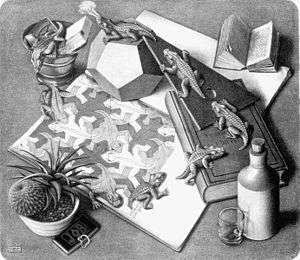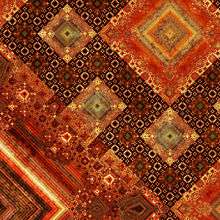Reptiles (M. C. Escher)
 | |
| Artist | M. C Escher |
|---|---|
| Year | 1943 |
| Type | lithograph |
| Dimensions | 33.4 cm × 38.5 cm (13.1 in × 15.2 in) |
Reptiles is a lithograph print by the Dutch artist M. C. Escher first printed in March 1943.
It depicts a desk upon which is a 2D drawing of a tessellated pattern of reptiles and hexagons. The reptiles at one edge of the drawing emerge into three dimensional reality, come to life and appear to crawl over a series of symbolic objects (a book on nature, a geometers triangle, a three dimensional/pentagonal dodecahedron, a pewter bowl containing a box of matches and a box of cigarettes) to eventually re-enter the drawing at its opposite edge. Other objects on the desk that may also be symbolic are a potted cactus and yucca, a ceramic flask with a cork stopper next to a small glass of liquid, a book of JOB cigarette rolling papers, and an open handwritten note book of many pages. Although only the size of small lizards, the reptiles have protruding crocodile-like fangs, and the one atop the dodecahedron has a dragon-like puff of smoke billowing from its nostrils.
Like many of Escher's works, the meaning of the imagery is enigmatic. There are, however, a number of scholarly interpretations of the work. One is that the lizard represents man, emerging from pure concept in two dimensions, becoming a three dimensional being, groping through life acquiring knowledge and wisdom, arriving at deep understanding of science and sacred geometric principals and the alchemical/spiritual nature of reality and existence, and finally descending to reunion with the realm of pure concept. In this theory the objects around the edge of the drawing are signals of the stages of emergence (cactus, biological life), the beginning of the fire-quest for knowledge (rolling papers), contemplation and distillation (a jug and partially consumed glass of spirits), deep study, understanding and wisdom (the open well-used notebook), and re-integration (matches and cigarettes symbolizing controlled/civilized fire that nonetheless consumes and returns the physical to the abstract).
Once a woman telephoned Escher and told him that she thought the image was a "striking illustration of reincarnation". Another anecdote revolves around the small book on the desk with the letters JOB printed on it. Many people believed it to represent the biblical Book of Job. This is understandable since the reptilian animal matches the description of the extinct creature "Leviathan" in chapter 41. The identity of the creature is difficult to determine as the book of Job is the oldest book in the Bible. Some say it may be Sarcosuchus Imperator. This ancient crocodyliform was discovered in Niger, Africa, which is near the proposed location of Uz, where the events of Job took place. The most likely interpretation of the small book in this work is that it is a book of JOB brand cigarette rolling papers that references the book in the Bible. It is uniquely coincidental how both the cigarette paper and Leviathan are related to fire.
In Popular Culture
A colorized version of the lithograph was used by rock band Mott the Hoople as the sleeve artwork for its eponymous first album, released in 1969.
See also
References
- Locher, J. L. (2000). The Magic of M. C. Escher. Harry N. Abrams, Inc. ISBN 0-8109-6720-0.
External links
- Decoration with Escher Lizard by William Chow.
